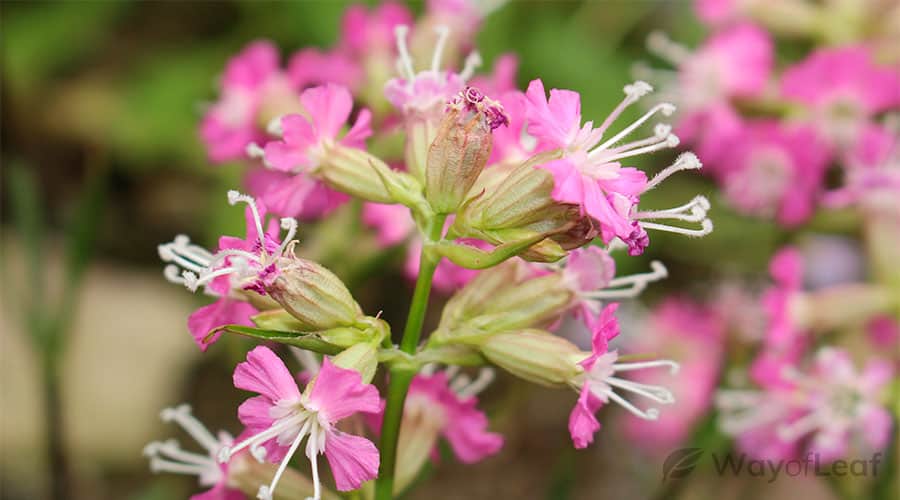Silene capensis, also known as African dream root, is a plant that enhances the power of dreams and has a long history of use by the native Xhosa people of South Africa, who regard the plant as sacred.
This article explores the traditional uses and modern-day research about the root and offers a guide if you’re interested in trying it yourself. Read below to find out more.

Want to experience the ‘magic’ of the Amanita muscaria mushroom? Iconic U.S. brand VidaCap has just launched a new range of 500mg Amanita gummies that soothe the mind and harmonize both body and spirit. Try them today and get 25% OFF all orders with WayofLeaf’s exclusive coupon code: AMANITAWOL
What Is African Dream Root?
African dream root goes by the scientific name of Silene capensis, also known as Silene undulata. It is an herb that grows natively in the Eastern Cape of South Africa. The Xhosa people of this region traditionally consume the plant roots as part of a mixture they call Ubulawu for spiritual and visionary purposes.
African dream root is an oneirogen, meaning it enhances the vividness of dreams. Some native South African traditions believe that visions that occur during dreaming, which oneirogens can enhance, are “true visions,” reflective of intuitive powers. On the other hand, they perceive hallucinations evoked by psychedelic plants as “impure and arbitrary visions.”

For the Xhosa, dreams are a way to connect to the ancestors. African dream root is therefore regarded as sacred, as it offers a way to help connect with supernatural knowledge and healing from spiritual entities. The relationship between the plant and the ancestors has lent its consumption to be a crucial part of the Xhosa mortuary ritual, where the body of a deceased loved one is brought back to their place of birth before burial.
The exact mechanism by which African dream root enhances dreaming is unknown. However, some researchers have proposed the psychoactive effects are because of saponins, molecules found in the plant which have powerful effects on the nervous system.
Furthermore, studies investigating the chemical make-up of other Silene plants have found the presence of 𝛃-carbolines – a type of alkaloid molecule thought to play an essential role in the psychoactive effects of ayahuasca.
How to Use African Dream Root
You can purchase African dream root from health food stores and online vendors. The root typically comes in the form of a ground powder but can also be bought in dosed capsules and the whole root form.
In traditional uses of African dream root, a crushed segment of the root is added to water and churned with a stick to produce a thick froth. The froth is then consumed on an empty stomach in the morning until the user vomits. The vomiting is seen as part of a spiritual cleanse. Before sleeping that evening, the user may consider what type of questions they’d like answered by the ancestors.
Other ways to consume African dream root could be by making a tea, in which you could add honey or sugar to sweeten the bitter taste of the plant. To make a tea, you need to first grind up the root with a pestle and mortar and then add it to a mug and stir with boiling water.
For some people who are less sensitive to African dream root, drinking the tea for multiple mornings in a row will allow the alkaloids to build up in the body system so they can feel more psychoactive effects.
African Dream Root Side Effects
Because there are no published studies on the safety of African dream root, it’s challenging to determine what the side effects are.
Its established saponins, the key ingredient in African dream root, can irritate the digestive tract lining and cause vomiting. However, as mentioned above, this purging effect could be seen as a cleansing benefit rather than a side effect.
Other side effects relating to the interaction of saponins with the digestive system could include:
- Abdominal pain
- Abdominal distension (abnormal swelling)
- Bloating
- Diarrhea
Research has also demonstrated that saponins interact with NSAIDs (nonsteroidal anti-inflammatory drugs). Therefore, taking African dream root and NSAIDs in combination could decrease the effectiveness of NSAIDs or even cause potential unknown effects.
Furthermore, in some instances, people may experience an intense, disturbing and confusing dream, which could cause them to feel distressed in the following days. If this happens to you, it may be a good idea to speak to an integration therapist so that they can help you to process the experience.
Silene Capensis Dosage
Again, it’s challenging to determine which doses of African dream root are safe because of the lack of safety studies. However, most online vendors and stores recommend using between 250-500 mg of the ground root (about a 3-4 inch piece of the root).

As with trying out all new substances, it’s always best to begin with small doses and gradually increase the dose to suit your needs.
Is African Dream Root Legal in the US?
Online sources suggest that African dream root is legal to possess, grow, and sell.
What Does Dreaming on African Dream Root Feel Like?
The effects of African dream root appear during sleep. With low doses, users may experience a deep and good quality sleepthat leaves them waking up feeling refreshed, whereas higher doses can lead to profound and vivid lucid dreams.
Themes and descriptive words from and about dreams following African dream root described on Erowid include:
- Intriguing
- Frightening
- Awe-inspiring
- Prophetic
- Feeling as if the dream was real
- Having the dreams show you important lessons you need to know
- Dreams with tribal imagery
- Religious experiences
- Euphoria
- Underwater imagery
- Lucid dreaming
African Dream Root: A Summary
African dream root has a long history of traditional use by the Xhosa, who believe the root can help open communication with the ancestors. The effects of African dream root tend to appear as profound and visual dreams.
Because of the lack of scientific research about African dream root, we still don’t know exactly how it works in the body and its long-term safety effects. Therefore, if you’re considering using African dream root, ensure you use the herb cautiously and purchase the root from a trusted source.

Want to experience the ‘magic’ of the Amanita muscaria mushroom? Iconic U.S. brand VidaCap has just launched a new range of 500mg Amanita gummies that soothe the mind and harmonize both body and spirit. Try them today and get 25% OFF all orders with WayofLeaf’s exclusive coupon code: AMANITAWOL











![Why Do People Use Hallucinogens? [Explained]](https://wayofleaf.com/wp-content/uploads/2020/12/wol-banner-why-do-people-use-hallucinogens-640x225.jpg)
![Psychedelic Integration [The Complete Guide]](https://wayofleaf.com/wp-content/uploads/2020/11/wol_psychedelic-integration-640x225.jpg)

